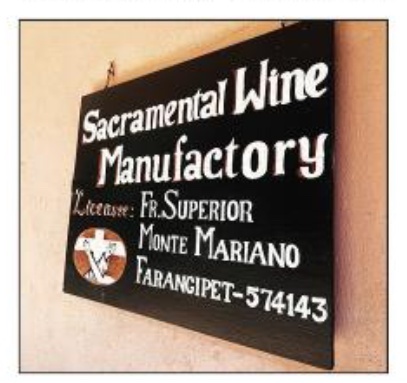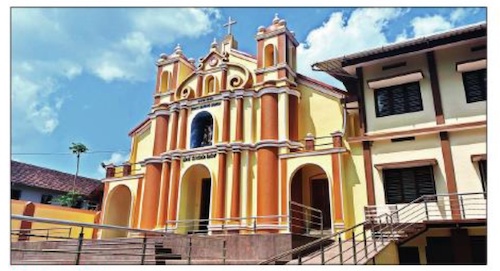Mangalore: Monte Mariano Friary
(Created page with "{| class="wikitable" |- |colspan="0"|<div style="font-size:100%"> This is a collection of articles archived for the excellence of their content.<br/> Additional information ma...") |
|||
| Line 7: | Line 7: | ||
|} | |} | ||
| − | + | ||
| − | + | ||
| − | + | ||
=Winemaking= | =Winemaking= | ||
| Line 36: | Line 36: | ||
Making wine with raisins was easy. The raisins were soaked in water and wine was prepared the traditional way. The only drawback wasthat this process didn’t yield much wine. But making wine from grapes is a lot harder. Fr Lobo says only red grapes with seeds are procured every two months. They are handcrushed by novices studying at the monastery. He recalls crushing grapes himself when he was a novice in the 1980s. |
Making wine with raisins was easy. The raisins were soaked in water and wine was prepared the traditional way. The only drawback wasthat this process didn’t yield much wine. But making wine from grapes is a lot harder. Fr Lobo says only red grapes with seeds are procured every two months. They are handcrushed by novices studying at the monastery. He recalls crushing grapes himself when he was a novice in the 1980s. | ||
| − | + | The grape pulp is shifted to a large tank where it remains for two days. On the third day, the juice is separated. The remaining pulp is transferred to another tank to extract leftover juice, and then the juice is poured into large containers and left to ferment for 21 days. Then, it is aged for one year in glass barrels in the wine cellar. The seeds and waste pulp are used to prepare manure. | |
“It is a completely natural and traditional process. OnlyCapuchins know how to do it right,” Fr Lobo says. The excise department permits production of only a certain quantity of wine in a year, and its licence is renewed every year. |
“It is a completely natural and traditional process. OnlyCapuchins know how to do it right,” Fr Lobo says. The excise department permits production of only a certain quantity of wine in a year, and its licence is renewed every year. | ||
| Line 44: | Line 44: | ||
===QUALITY CHECK=== | ===QUALITY CHECK=== | ||
Wine used during Holy Mass must be natural, from the fruit of the grape, pure and incorrupt, and not mixed with other substances, a June 2017 circular from the Vatican regarding bread and wine for the Eucharist says. “Great care should be taken so that the wine. . . for the celebration of the Eucharist is well conserved and has not soured. It is altogether forbidden to use wine of doubtful authenticity or provenance… nor are other drinks of any kind to be admitted. . . as they do not constitute valid matter,” it adds. The only valid alternative is ‘mustum’ or pure grape juice, which can be served to people who cannot have alcohol. |
Wine used during Holy Mass must be natural, from the fruit of the grape, pure and incorrupt, and not mixed with other substances, a June 2017 circular from the Vatican regarding bread and wine for the Eucharist says. “Great care should be taken so that the wine. . . for the celebration of the Eucharist is well conserved and has not soured. It is altogether forbidden to use wine of doubtful authenticity or provenance… nor are other drinks of any kind to be admitted. . . as they do not constitute valid matter,” it adds. The only valid alternative is ‘mustum’ or pure grape juice, which can be served to people who cannot have alcohol. | ||
| + | |||
| + | [[Category:Economy-Industry-Resources|M | ||
| + | MANGALORE: MONTE MARIANO FRIARY]] | ||
| + | [[Category:India|M | ||
| + | MANGALORE: MONTE MARIANO FRIARY]] | ||
| + | [[Category:Pages with broken file links|MANGALORE: MONTE MARIANO FRIARY]] | ||
| + | [[Category:Places|M | ||
| + | MANGALORE: MONTE MARIANO FRIARY]] | ||
Latest revision as of 14:23, 15 November 2022
This is a collection of articles archived for the excellence of their content. |
[edit] Winemaking
[edit] 2022
Kevin Mendonsa, Nov 5, 2022: The Times of India

From: Kevin Mendonsa, Nov 5, 2022: The Times of India

From: Kevin Mendonsa, Nov 5, 2022: The Times of India

From: Kevin Mendonsa, Nov 5, 2022: The Times of India
Christians believe wine turns into the blood of Jesus during the Holy Mass or Eucharist, and Capuchin monks at the 500-year-old Monte Mariano Friary in Mangalore have been transforming grapes into sacramental wine for the past six decades. It’s a special wine used only in the celebration of Holy Mass or liturgical services at churches – the rules are clear that sacramental wine cannot be used for personal consumption.
Monte Mariano means Mount of Mary, and the friary (a residence for friars, or monastery) dates back to 1526. It is located high on a cliff overlooking the Nethravathi river, about 10km from Mangalore City in Karnataka’s Dakshina Kannada district. It is also home to an ancient Catholic outpost that, at various times, has been church, friary, monastery, and seminary. It comesunder Holy Trinity Province, Karnataka, and is run by the Order of Friars Minor Capuchin, a religious order of Franciscan friars founded by Saint Francis of Assisi whose monks follow vows of poverty, chastity and obedience.
60 Years Of Winemaking
Fr Gerald Lobo, former superior of Monte Mariano Friary, recalls that the monks got into the mission of vinificationwith a licence from the excise department around 1958. “Prior to this, sacramental wine was imported from Australia across all churches in India. It was stopped due to import issues, and that’s when the then bishop of the Diocese of Mangalore made an oral request to the Capuchins to give a thought to winemaking, around 1955. The Capuchins humbly accepted the Bishop’s request and started a new mission which has been continued diligently. ” Fr Lobo says thebishop urged the monks to get into winemaking because “in western countries, orders of the Franciscans were known for sacramental winemaking”.
Nothing But Grapes
Fr Lobo says sacramental wine is made only from grapes, with no additives like yeast, sugar, artificial flavours or colours. In the early years the Monte Mariano winery made wine from dry raisins imported from Afghanistan and Tibet. But when the price of raisins soared in the 1980s, the Capuchins started using locally available grapes with seeds, procured from Bengaluru.
Making wine with raisins was easy. The raisins were soaked in water and wine was prepared the traditional way. The only drawback wasthat this process didn’t yield much wine. But making wine from grapes is a lot harder. Fr Lobo says only red grapes with seeds are procured every two months. They are handcrushed by novices studying at the monastery. He recalls crushing grapes himself when he was a novice in the 1980s.
The grape pulp is shifted to a large tank where it remains for two days. On the third day, the juice is separated. The remaining pulp is transferred to another tank to extract leftover juice, and then the juice is poured into large containers and left to ferment for 21 days. Then, it is aged for one year in glass barrels in the wine cellar. The seeds and waste pulp are used to prepare manure.
“It is a completely natural and traditional process. OnlyCapuchins know how to do it right,” Fr Lobo says. The excise department permits production of only a certain quantity of wine in a year, and its licence is renewed every year.
The wine is now ready but it is bottled only on order and used in the dioceses of Mangalore, Chikmagalur, Udupi, and Belthangady. During Mass or prayers, priests use about 10-15 ml of wine, which is poured into a chalice.
[edit] QUALITY CHECK
Wine used during Holy Mass must be natural, from the fruit of the grape, pure and incorrupt, and not mixed with other substances, a June 2017 circular from the Vatican regarding bread and wine for the Eucharist says. “Great care should be taken so that the wine. . . for the celebration of the Eucharist is well conserved and has not soured. It is altogether forbidden to use wine of doubtful authenticity or provenance… nor are other drinks of any kind to be admitted. . . as they do not constitute valid matter,” it adds. The only valid alternative is ‘mustum’ or pure grape juice, which can be served to people who cannot have alcohol.